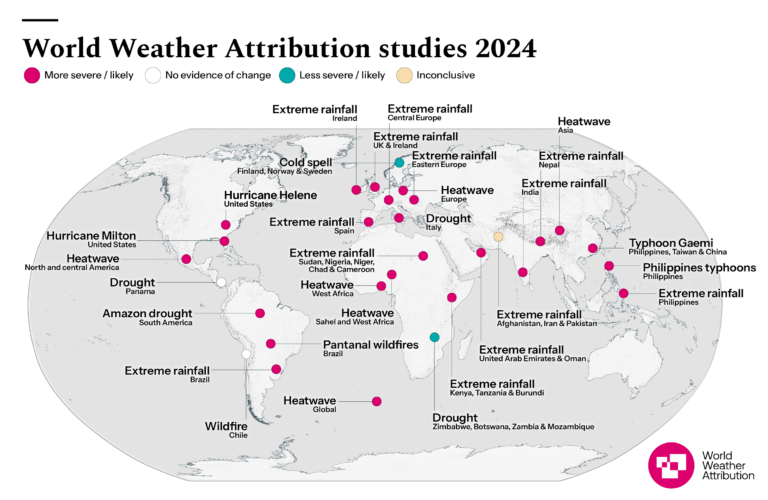A recent report reveals that human-induced climate change has added an average of 41 days of “dangerous heat” by 2024, significantly harming human health and ecosystems. The analysis, conducted by World Weather Attribution (WWA) and Climate Central, highlights the severe impacts of fossil fuel-driven global warming.
Dr. Friederike Otto, director of WWA and professor at Imperial College London said, “The effects of fossil fuel-induced warming have never been so clear or devastating as they will be in 2024. We are living in a dangerous new era.” Experts predict 2024 will be the hottest year on record, marked by unprecedented extreme weather events fuelled by climate change.
In 2024, WWA recorded 219 major extreme events, finding clear evidence of climate change’s influence in 26 out of 29 analysed cases. Catastrophic weather events, including floods in Spain, hurricanes in the United States, drought in the Amazon, and flooding in Africa, have claimed thousands of lives, displaced millions, and caused widespread suffering.
One notable event was the DANA (segregated low tide) in Spain, which left over 220 people dead in Valencia. WWA found climate change increased the intensity of the rains by 12% and doubled their likelihood. Similarly, Hurricane Helene, one of the deadliest in the US since Katrina in 2005, killed 230 people across six states. WWA linked the hurricane’s high sea temperatures to a 200-500 times higher probability due to climate change, with rainfall intensified by 10%.
Climate Central has noted that climate change has increased the likelihood of warming Atlantic temperatures adding moisture to storms by 50 to 300 times. Days later, the European ClimaMeter project determined that natural climate variability alone cannot explain the amount of precipitation observed.
In the Amazon, WWA highlighted that meteorological drought has become ten times more likely, while agricultural drought is now 30 times more frequent. Scientists warn that prolonged droughts threaten to transform the rainforest into a drier state, risking mass tree die-offs and significant carbon dioxide emissions.
The annual report by WWA and Climate Central highlights that while natural phenomena like El Niño contributed to some events, climate change remains the primary driver of 2024’s extremes. Climate Central notes that warming Atlantic temperatures have increased storm moisture by 50-300 times, further amplifying severe weather events.
In Africa, floods across Sudan, Nigeria, Niger, Cameroon, and Chad were the deadliest of the year, with at least 2,000 fatalities and millions displaced. Hurricane Milton in the US further demonstrated global warming’s impact, with similar findings on intensified rainfall and higher sea temperatures.
Looking ahead, WWA and Climate Central emphasise the urgent need for four critical measures to combat climate change and mitigate the risks of extreme weather. These include accelerating the global transition from fossil fuels to renewable energy, enhancing early warning systems to improve disaster preparedness, implementing real-time notifications to address heat-related deaths, and providing international financing to support developing nations in building resilience against climate impacts.
Dr. Otto emphasised the urgency of these actions, cautioning against over-reliance on carbon dioxide removal technologies and said, “We have the knowledge and technology to transition to renewables, reduce demand, and halt deforestation. These measures must take precedence.”





















